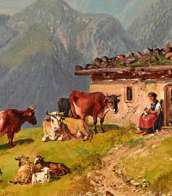julius adam ii

Julius Adam d. J. was a German animal painter who became known primarily for his paintings of kittens, for which he earned the nickname Kittenadam. His father Julius Adam the Elder was a photographer and lithographer.


Julius Adam d. J. was a German animal painter who became known primarily for his paintings of kittens, for which he earned the nickname Kittenadam. His father Julius Adam the Elder was a photographer and lithographer.


Julius Adam d. J. was a German animal painter who became known primarily for his paintings of kittens, for which he earned the nickname Kittenadam. His father Julius Adam the Elder was a photographer and lithographer.


Julius Adam d. J. was a German animal painter who became known primarily for his paintings of kittens, for which he earned the nickname Kittenadam. His father Julius Adam the Elder was a photographer and lithographer.


Julius Adam d. J. was a German animal painter who became known primarily for his paintings of kittens, for which he earned the nickname Kittenadam. His father Julius Adam the Elder was a photographer and lithographer.


Julius Adam d. J. was a German animal painter who became known primarily for his paintings of kittens, for which he earned the nickname Kittenadam. His father Julius Adam the Elder was a photographer and lithographer.


Julius Adam d. J. was a German animal painter who became known primarily for his paintings of kittens, for which he earned the nickname Kittenadam. His father Julius Adam the Elder was a photographer and lithographer.


Julius Adam d. J. was a German animal painter who became known primarily for his paintings of kittens, for which he earned the nickname Kittenadam. His father Julius Adam the Elder was a photographer and lithographer.


Julius Adam d. J. was a German animal painter who became known primarily for his paintings of kittens, for which he earned the nickname Kittenadam. His father Julius Adam the Elder was a photographer and lithographer.


Adam van Breen, born in Amsterdam in 1585 and passing in Norway in 1642, was a notable Dutch Golden Age painter who specialized in winter landscapes. His work is distinguished by its vivid depiction of the icy, bustling life of the Netherlands during the winter months. Van Breen became a member of the Hague Guild of St. Luke in 1612 and worked in various cities including The Hague, Amsterdam, and later Oslo, Norway.
While detailed biographical information about van Breen remains scarce, it is known that he married in 1611 and was registered in the Dutch town’s guild the following year. His artistic style is often compared to that of Adriaen van de Venne, with whom he shared a preference for winter scenes. However, van Breen drew inspiration primarily from Hendrick and Barendt Avercamp, setting his characters apart through their more assertive, stockier figures, sometimes even including portrait-like depictions within his compositions.
Adam van Breen's paintings are celebrated for incorporating figures in luxurious clothing, a reflection of The Hague's status as a political and cultural center. This influence is apparent in his landscape works, which not only capture the beauty of the Dutch winters but also subtly document the societal contexts of the period. In 1617, van Breen illustrated military evolutions for the Prince of Nassau, showcasing his versatility beyond landscapes. His move to Norway in the 1640s introduced a new phase in his career, where he produced several notable portraits.
For collectors and experts in art and antiques, Adam van Breen's work offers a fascinating glimpse into the Dutch Golden Age, characterized by its detailed and lively winter scenes. His paintings, such as those documented in private collections and galleries, remain a testament to his skill and distinctive approach to capturing the essence of his time.
To stay updated on new discoveries, sales, and auction events related to Adam van Breen, signing up for updates from relevant art galleries and auction houses is recommended. This ensures access to the latest information on available works and exhibitions featuring this remarkable Dutch painter.



Andreas Vesalius (Dutch: Andries van Wesel) was a Flemish physician, one of the first anatomists of the Renaissance.
Vesalius came from a family of physicians and apothecaries, studied at the Catholic University of Leuven and at the medical school of the University of Paris, where he learned to dissect animals. He also had the opportunity to dissect human cadavers and devoted much time to the study of human bones. He later went to the University of Padua and, after earning his MD degree, was appointed professor of surgery, whose duties included anatomical demonstrations.
Vesalius revolutionized the study of biology and medical practice through his careful description of the anatomy of the human body. Based on observations made by himself, he wrote and illustrated the first complete textbook of anatomy. In 1543 his major work De humani corporis fabrica libri septem ("Seven Books on the Structure of the Human Body"), commonly known as Fabrica, was printed. In this epochal work, Vesalius gave far more extensive and accurate descriptions of the human body than anything that had been done by his predecessors.
In the same year, 1543, the Holy Roman Emperor Charles V appointed him staff physician of his house, and in 1559 Vesalius became physician to the Madrid court of Charles V's son, Philip II.
Vesalius' work made anatomy a scientific discipline with far-reaching implications not only for physiology but for all of biology.




























































